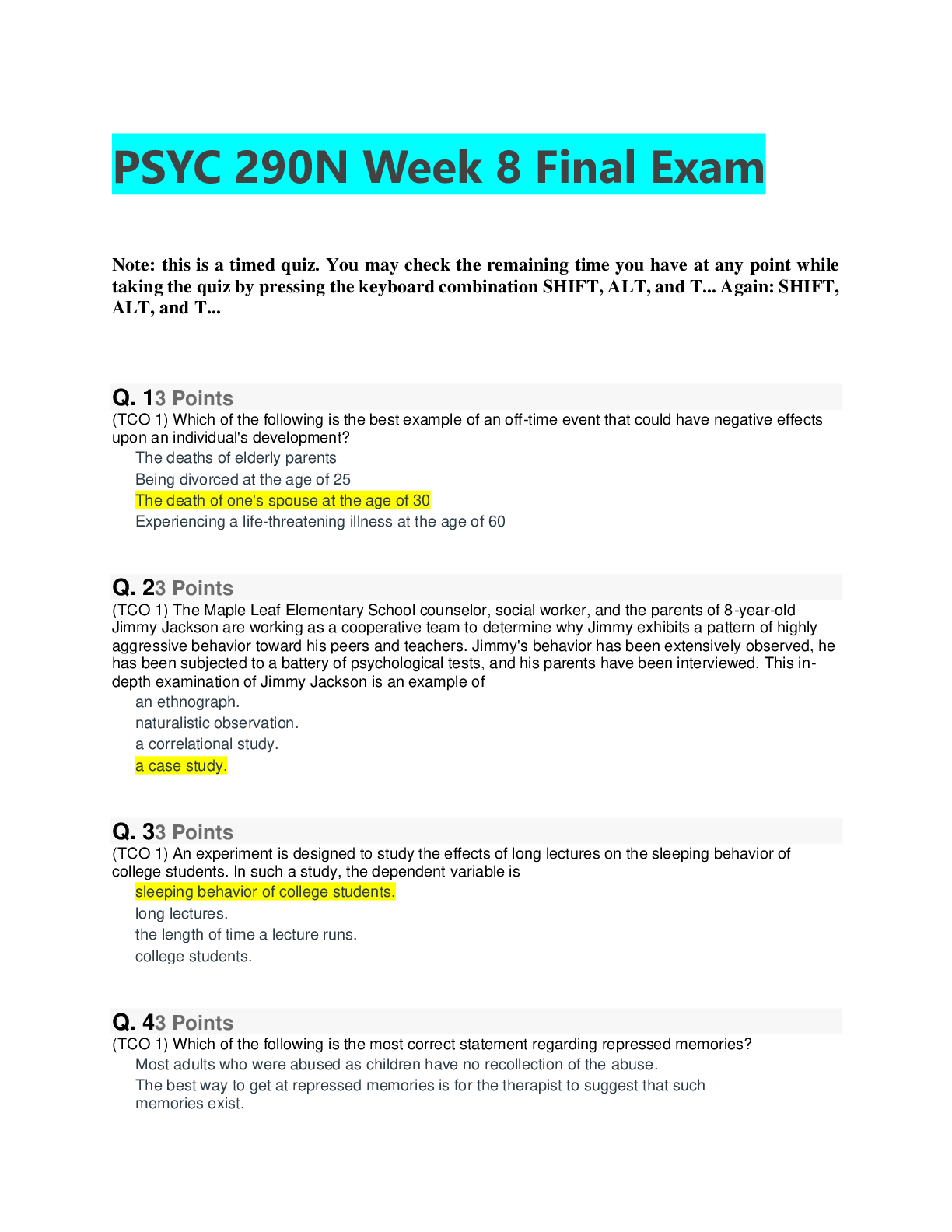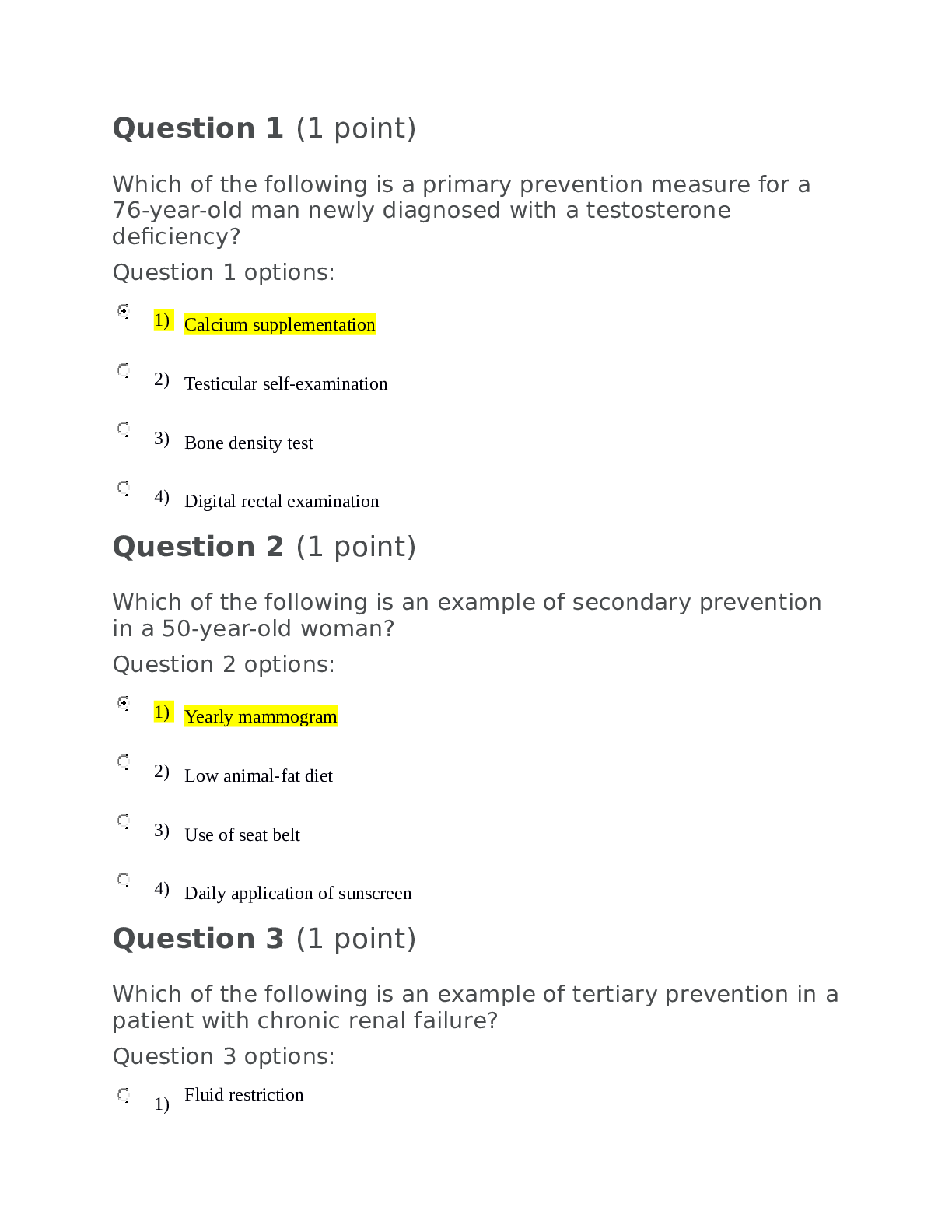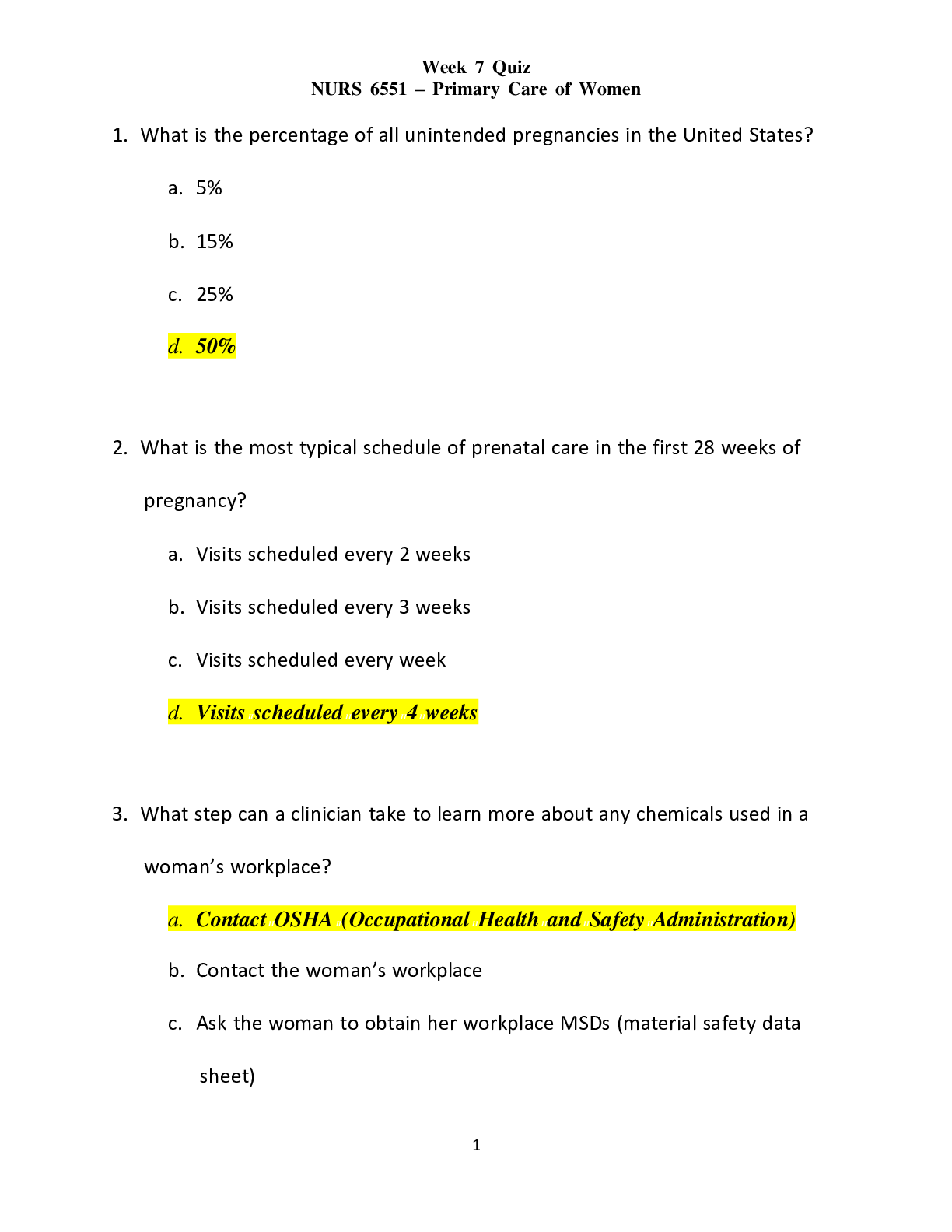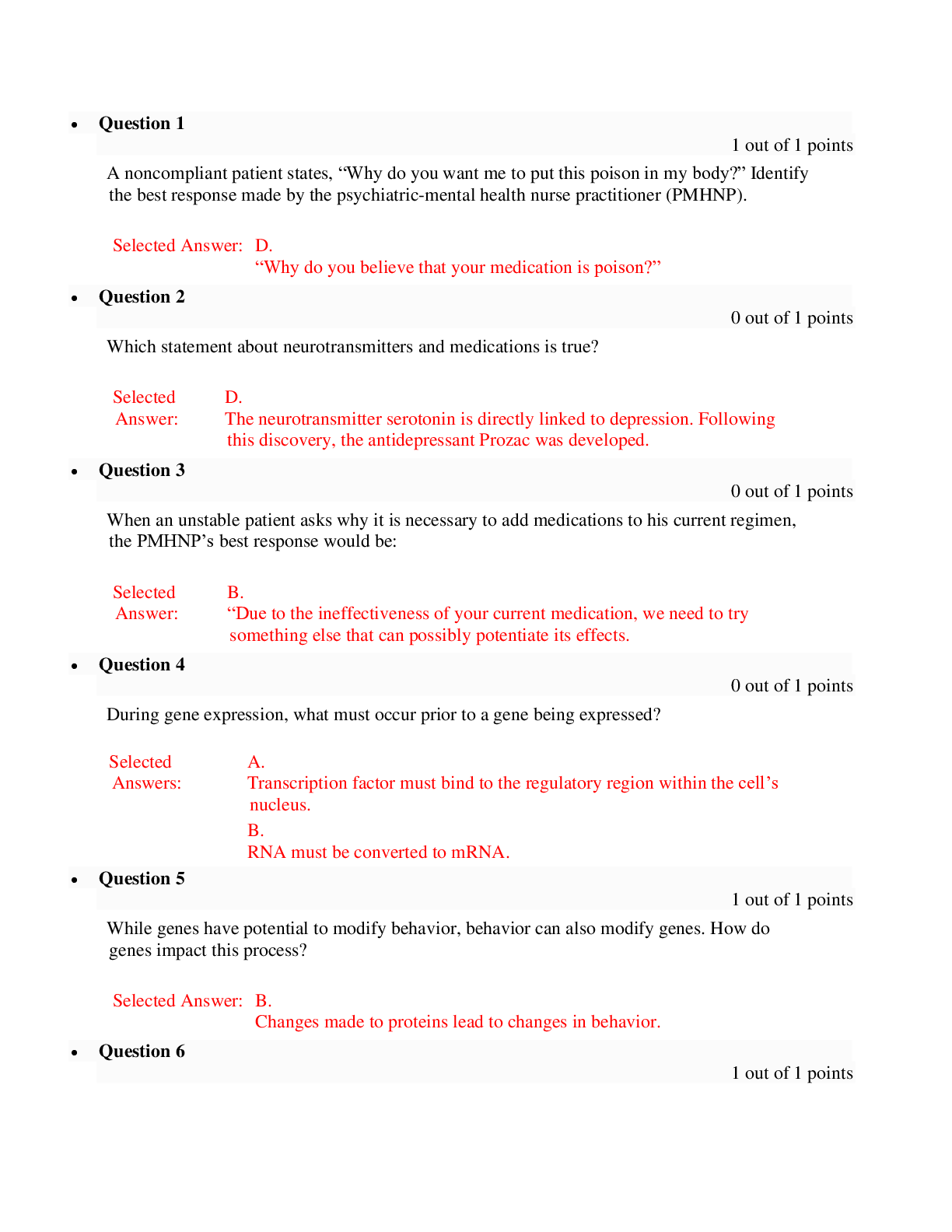*NURSING > EXAM > CCRP Nutritional Management Exam (GRADED A) Questions and Answers (100% Correct Elaborations) (All)
CCRP Nutritional Management Exam (GRADED A) Questions and Answers (100% Correct Elaborations)
Document Content and Description Below
Macronutrient nutrients which provide energy, carbohydrate, protein, fat Micronutrient includes macro minerals, organic acids, trace minerals, and vitamins Food plans/patterns ways of gr... ouping types of food in consistent pattern - Mediterranean diet pattern, DASH plan, ATP III Dietary guidelines, vegetarianism (including vegan) Nutraceutical nutrients consumed not within food via supplementation Functional foods foods that have had nutrients not normally found or in high quantity added to the food What study showed the progressive relationship between saturated fat (SF) intake and CVD death was observed The Seven Centuries Study Academy of Nutrition and Dietetics has long recommended the emphasis on what? Total diet and overall food patterns, this keeps foods from being demonized and encourage greater variety, higher nutrients, and increases compliance External influences on food choices include cultural context, historical experience, belief systems, food supply, and socioeconomic status. Internal influences include both physiological and emotional responses to food. Taste and preference have genetic and environmental origins. Food choices include Pattern, Nutrient and Volume are limited checklists of foods and beverages with a frequency response section for patients to report how often each item was consumed over a specified period of time Food Frequency Questionnaires (FFQ) Which tools yield a precise analysis of nutrient content? diet histories, diet records, and 24-hour recalls Disadvantages: time intensive, need trained professional Name examples of tools that measure consistency with a diet plan/pattern that is to be taught or prescribed. These tools are helpful or evaluating diet quality as well as behavior change, compliance, or nutrition education. MEDAS, MedDietScore, DASH Adherence Score19 Name the advantages of self-administered food frequency questionaires and/or screeners both brief and extended, may be evaluated by a variety of health care personnel. Evidence based nutrition recommendations for CVD: fruits and vegetables -Epidemiological studies indicate an inverse association between plant-based foods and CVD -Evidence suggests that the benefit of fruits and vegetables may be due to: • Micronutrients, fiber and phytochemicals • Potentially enhanced bioavailability in food form • Replacement of less healthy diet components23 ______________ are complex group of secondary plant metabolites. ___________ rich food consumption may offer a protective effect on CVD and is associated with a reduction of CVD in humans and animals. Polyphenols True or False Supplementation of Vitamins C and E, Beta-carotene and Co-enzyme Q-10 demonstrates decreased risk of CVD events. False NIH State of Science Conference on Vitamin and Mineral Supplementation and chronic disease prevention concluded there is not enough evidence for or against supplementation of antioxidants What did the Nurses' Health Study26 find concerning nut consumption and CHD events. Women who ate greater than 50 nuts per week had significantly lower risk than non-consumers. Name the components of nuts thought to be beneficial in reduction of CVD risk: monounsaturated and polyunsaturated fatty acids, high in arginine and low in lysine, fiber, tocopherols, folic acid, magnesium, copper, flavonoids, and plant sterols. Nurses' Health Study, Women's Health Study, Cardiac Risk Development in Young Adults Study, N Hanes Survey, and N Hanes follow-up all found what about fiber? the highest intakes of total or soluble fiber were associated with reduced risk of CHD and CVA.27 The Nurses' Health Study specifically found an inverse relationship between fiber intake and fatal and nonfatal cardiac events. How does alcohol prolong blood clot formation? Alcohol beneficially prolongs blood clot formation by lowering levels of fibrinogen and protein type plasminogen activator. People who drink alcohol at a rate of 1-2 drinks a week have approximately have _____ lower relative risk of CVD death 1-2 drinks approximately have 35% lower relative risk for persons who consumed various endpoints including CVN mortality, CVD, fatal and non-fatal MI, and CHD.28 But in a Danish cohort, consumption of a larger amount of alcohol (3-5 drinks/day) increased CVD mortality by 35%. What types of foods should be avoided (protein): Processed Meats When specific types of meat were examined, processed meats were associated with higher CVD risk, even when SFA content was controlled. Meats (processed and unprocessed) were associated with higher CVD risk than when these foods replaced low fat dairy, nuts, and fish What types of foods should be avoided (grains): Refined Carbohydrates Sugar may increase blood pressure and weight gain, both risk factors for heart disease, or it may raise bad cholesterol and triglycerides and lower good cholesterol. Sugar may also increase insulin resistance, a factor in diabetes, or increase fat accumulation in the liver What types of food should be avoided (fats): The Dietary Guidelines for Americans 2010 and the Institute of Medicine recommend that individuals keep trans fatty acid consumption as low as possible. Natural Trans Fats (nTFA) found in small amounts in the fatty parts of meat and dairy products. Artifical Trans Fats (rTFA) comes from foods that contain partially hydrogenated oil and is formed when hydrogen is added to liquid oil turning it into solid fat. Food manufacturers use rTFA in food products because it is inexpensive and it increases the food's shelf life, stability, and texture Polyunsaturated fatty acids (PuFa N-3 and N-6) There is an inverse relationship observed in patients who consumed N-3 PUFA in foods: a 30−45% reduction in fatal myocardial infarctions. The data also suggest that higher intakes appear to be safe and may be even more beneficial (as part of a low-saturated-fat, low-cholesterol diet) What trial sought to compare Mediterranean diet and low fat diet in relation to major cardiac events. The PREDIMED trial sought to compare Mediterranean diet and low fat diet in relation to major cardiac events. The "low fat" diet in reality was not low fat (approximately 30% calories from fat)although participants were advised to consume low fat foods. When the consumed diets were compared, the addition of plant sterols to the olive oil and nuts demonstrated the most significant reduction CV events. Dietary Approaches to Stop Hypertension (DASH) diet plan have been proposed and studied; the most recent versions have decreased carbohydrates to 40% of total calories and increased poly- and monounsaturated fats or protein. The recommended plan has very low levels of sodium content. The China Study demonstrated a correlation between plant-based diet and less incidence of heart disease (and cancer) Vegetarians exhibited a ____ reduction in ischemic heart disease mortality Vegetarians exhibited a 25% reduction in ischemic heart disease mortality Japanese diet (specifically soy, seaweed, vegetable, fruit and green tea, and some fish) was shown to be associated with decreased risk of CVD mortality.43 Okinawan diets include root vegetables, leafy greens, seaweed, and herbaceous plants. Okinawans also experienced some of the lowest rates of CVD in the world Evidence Based Nutrition Recommendations for Dyslipidemia ... True or False The types of fats consumed appear to be far more relevant for CVD risk reduction than the proportion of calories consumed from fat. True True or False High levels of LDL circulating in the blood are susceptible to lipid peroxidation that results in oxidized LDL being scavenged by microphages lining certain arteries particularly around the heart leading to atherosclerosis True The reduction of _____ cholesterol caused by a decrease in SFA appears to be specific to larger more buoyant particles. These particles contain a greater proportion of cholesterol. LDL Reducing saturated fat lowers both LDL-C and HDL-C; but the absolute effect tends to be greater for LDL-C than HDL. The length of the carbon chain in saturated fats may be related to toxicity. Medium chain SFA increase total serum cholesterol primarily through an increase in LDL. Shorter chains SFA have been found to have important antiviral and antimicrobial and immune response functions. Medium or long chain fatty acids have different effects: stearic acid has been shown to have a neutral effect on LDL, but palmitate has the more harmful influence on increasing LDL and may enhance thrombogenesis when substituted for stearate ________ are shown to increase serum levels of LDL, apoprotein(a), and lower HDL. This type of fat has the strongest adverse relationship with CVD risk factors and their consumption should be as close to zero as possible Trans Fats ________ are dietary triglycerides that contain fatty acids with two or more double bonds. The most common are alpha-linolenic (ALA), an omega-3 fatty acid, and linoleic (LA), an omega-6 fatty acid, (3 or 6 refers to the placement of the double bond on the fatty acids chain). They are not synthesized by humans and thus are considered essential dietary nutrients. Polyunsaturated Fatty Acids (PUFA) Eicosanoids Eicosanoids are a group of hormones intimately involved in the body's inflammatory and homeostatic processes, which include the prostaglandins, leukotrienes, and thromboxanes, among others. Omega-6 and omega-3 eighteen-carbon polyunsaturated fatty acids compete for the same metabolic enzymes, thus the omega-6:omega-3 ratio of ingested fatty acids has significant influence on the ratio and rate of production of eicosanoids. True or False Humans have a limited ability when the diet includes the shorter-chain omega-3 fatty acid to make the longer-chain fatty acids from ALA and this may be impaired in aging. True EPA (inversely) and ARA (directly) affect inflammation modulation, platelet aggregation, cell growth and proliferation, smooth muscle contraction and vasoconstriction (n-6) and vasodialative (n-3) effects. The cardiovascular effect of raising total PUFA consumed has been studied extensively due to its beneficial effect upon lowering lowering LDL and total cholesterol (TC). Omega 6 (n-6) PUFA may reduce inflammation and is associated with lower LDL (yet larger), lower VLDL (size and number), and higher HDL (size and number) Oleic acid MUFA -Oleic acid (medium chain length) is one of the most abundant fatty acids and is found in high amounts in olive oil and canola oils, but is also present in modest amounts (20-30%) in beef fat, palm oil, soybean, and corn oil Which as a better improvement in lipid profile PUFAs or MUFAs? When MUFAs replace SFA they demonstrate a positive influence on the lipid profile and possible improvement in insulin resistance, but PUFAs had a greater benefit Cholesterol is an organic molecule found in cell membranes and serves as a precursor to biosynthesis of some hormones and Vitamin D. True or False 85% percent of cholesterol is found in foods. False Eighty-five percent of circulating cholesterol is endogenous and 15% from food. Does saturated fat consumed with cholesterol potentiate effects on lipids? True Saturated fat when consumed with cholesterol may potentiate its effect on TC and LDL and thus should be controlled when reviewing studies regarding cholesterol and diet. The AHA/ACC recommendations state there is insufficient evidence that lowering dietary cholesterol reduces LDL-C. Would lowering dietary cholesterol reduce your LDLs? The AHA/ACC recommendations state there is insufficient evidence that lowering dietary cholesterol reduces LDL-C. Name the four forms of carbohydrates: Carbohydrates are hydrates of carbon and are found in four forms: mono-, di-, oglio- and polysaccharides. Simple CHO Simple CHO refers to mono and disaccharides that are easily absorbed in the GI tract (does not require digestion). Foods are neither exclusively simple nor complex, but a combination of both. Complex Carbs Complex CHO refers to oglio and polysaccharides; it does not refer to fiber content. Foods are neither exclusively simple nor complex, but a combination of both. Glycemic load refers to the serum glucose-raising capability of an isolated food item. What increases when you consume greater than 65% of your calories as carbohydrates? Higher intakes (> 65% of calories consumed) of CHO lead to increases in plasma triglycerides (TG) and reductions in HDL. Consuming whole grains improves the glucose/insulin homeostasis and endothelial function, and reduces inflammation. The benefit with replacing SFA with CHO is ______ than that of PUFA less Name examples of soluble fiber glycan, psyllium gums, and pectin Soluble fiber _______ LDL. lowers What combines with fluids and forms a gel which can increase elimination of bile acids stimulating hepatic conversion of cholesterol to new bile acids, increasing hepatic uptake of LDL and reduction serum LDL. Consumption of whole grain oats lowers LDL without lowering HDL. Soluble Fiber Phytosterols chemically related and structurally similar to cholesterol. They are found to decrease TC and LDL by reducing dietary and biliary cholesterol absorption by being preferentially selected. Plant sterols lower _____. lowering TG What is often added to foods such as milk, margarine, orange juice, olive oil, cheese, snacks and breads to help lower TG? These foods are examples of . . . Plant Sterols, Functional foods What kind of wine should you drink for health benefits The drier the wine (less sugar), the less likely it is to raise TG. A moderate consumption (< 30 mg/day = approximately 2 drinks) increases HDL but also raises TG.75 Red wine can have cardioprotective effects by providing polyphenol (resveratrol) and reducing LDL, further boosting HDL and inhibition of clotting mechanisms. True or False Studies have conclusively shown no benefit on lipoprotein profile with supplemental vitamins. Current evidence is insufficient to recommend for or against supplement use. True What stuff does fish contain that is "good"? Fish contains high quality protein, unsaturated fats, and long chain omega 3 (EPA and DHA) fatty acids. Name types of fatty fish that have highest amounts of omega 3: Fatty fish (generally ocean fish) such as anchovies, sardines, trout, white tuna, farmed and wild salmon Name the four main benefits of fish: Fish intake is associated with lower TG, and may reduce inflammation, improve endothelial function, and limit platelet aggregation Should you eat Tilapia? Are all fish equal in nutrients? Tilapia, an inexpensive frequently consumed mild fish, contains a prevalence of long chain omega-6 fatty acids, which act as a precursor to ARA and may be proinflammatory. Name the three things that eating nuts helps lower: nut consumption reduces TC, LDL, and apolipoprotein. Name the kind of nut that is high in LA and are also a source of plant stanols? walnuts Name three reasons why fruits and vegetables are beneficial to your health: Evidence suggests their benefit may be due to: • Micronutrients, fiber, and phytochemicals • Potentially enhanced bioavailability in food form • Replacement of less healthy diet component23 What are the following omega fatty acids: ALA and LA common PUFAs are alpha-linolenic (ALA), an omega-3 fatty acid, and linoleic (LA), an omega-6 fatty acid, What's bad in red meat? SATURATED FAT and possibly L-carnitine as the agent for increased CV risk via its influence on artery clogging HOWEVER L-carnitine supplementation has been shown to be beneficially associated with 27% reduction in all-cause mortality Is white meat better? "white" has modestly lower cholesterol than beef and is variable in its saturated fat content Name the benefits and componenets of low-fat dairy: Low-fat dairy foods contain calcium, high quality protein, linoleic acid, vitamins, and other nutrients. As a component of diet patterns it has been associated with lower lipids and improved endothelial function. Name some diet plans/patterns that have been shown to help CVD DASH, Mediterranean, vegetarianism, myPlate The AHA/ACC Lifestyle recommends (strong evidence to support) a diet plan which emphasizes vegetables, fruits, whole grains, low fat dairy products, poultry, fish, legumes, non-tropical vegetable oils, and nuts and which limits sweets, sugar-sweetened beverages, and red meat. Does the DASH plan include alcohol in modest amounts and low fat dairy? True Which eating plan is generally higher in total fat (moderate at 32-35% of total calories) and higher in MUFA (due to emphasis of olive oil Mediterranean Diet Which plan was also shown to be beneficial in populations, including men, women, African American and non-African American, hypertensive and non-hypertensive. Evidence: strong DASH Explain the obesity paradox The observed paradox is the contradiction that obese patients have lower mortality than normal weight individuals. Hypotheses for this unexpected observation are debated but possible explanations include visceral fat accumulation in normal weight individuals causing an increased risk of CVD due to increasing insulin resistance Evidence based nutrition recommendations for obesity: name caloric intake for weight loss in men 1500−1800 calorie diet plans for men Evidence based nutrition recommendations for obesity: name caloric intake for weight loss in women 1200−1500 calorie diet plans for women How many calories should be reduced per day? Prescribe 500 kcal/day or 750 kcal/day energy deficit This deficit is tolerated best by a combination of increased energy expenditure and reduced energy intake. If fat content is lowered what will be the different outcomes of increasing carbs or increasing protein If fat content is low (< 20% of total calories), the macronutrient component selected as a fat replacement will yield different outcomes. Replacing fat with simple, high glycemic foods has been shown to be related to weight gain. Intake of high fiber carbohydrates was inversely related to body weight. Replacing fat with protein or raising the proportion of protein has not shown consistent effect on CVD risk likely due to variation in self-selection of protein from animal or plant sources and simple versus complex CHO. hypocaloric target hypocaloric (500-750 calorie reduction and not more) eating plans When using portion control and DASH eating plan what is the recommended percent of weight loss to achieve in 6 months? attain 3-5% weight loss in 6 months Based on the JNC 7 report, a weight loss of as little as _____ reduces blood pressure and/or prevents hypertension in a large proportion of overweight persons 10 lbs Name three vitamin and mineral deficiencies that have been implicated in hypertension: Insufficient intakes of potassium, calcium and magnesium below DRI have been implicated in hypertension What does acute caffeine use do to BP? raises it, chronic affects have not been studied How much alcohol intake may reduce BP by 2-3 mmHG? What happens if you drink a lot more? Alcohol intakes less than or equal to 2 drinks a day for men and one drink per day for women may reduce BP by 2-4 mmHg. Patients who consume chronic high intakes of alcohol may increase the risk for higher BP one and a half to two times. What does Diabetes make CVD worse? The presence of diabetes compounds the risk of CVD due to insulin resistance and elevated triglycerides leading to an increase in LDL. What helps diabetics stay maintain appropriate CHO intake? Monitoring CHO, whether by CHO counting, choices, or experience-based estimation remains a key strategy in achieving glycemic control. Protein and diabetic patients: Protein increases insulin response and has no effect on blood glucose levels. Therefore protein is an important component of every meal and should not be used to treat hypoglycemia.For individuals without diabetic kidney disease, higher protein eating patterns (30% of calories) may or may not improve A1C; however, they appear to improve one or more CVD risk measures. High fat diets and A1C: High fat diets were positively related to HbA1C and when the fat was reduced, HbA1C declined. In patients who take insulin, meals that are high in fat may require more insulin than low fat meals Recommendations for weight loss for patients with CVD and diabetes Weight management (loss of 5-10% of initial body weight if BMI > 30), increased activity level and diet plans which support CHO control are essential and can delay or prevent further disease progression Heart Failure (HF) is characterized by impaired cardiac output. Acute or chronic heart injury leads to cardiac remodeling in an effort to sustain blood to the body. Heart compensates for the loss of cardiac output by increasing force and rate of contraction stimulating angiotensin system and sodium and fluid retention aggravating status General recommendations for dietary salt and water for HF patients recommendations are less than 2000-3000 mg sodium consumed in a day in conjunction with less than 2 liters of fluid consumed What's strange that's going on in HF patients and dietary salt? The AHA/ACC guidelines recommend further studies evaluating the effects of sodium restriction on the neurochemical activation and outcomes in patients optimally treated in heart failure. Some studies are showing more salt (2400) is better. 2013 AHA/ACC Guidelines for Heart Failure suggest a Class II recommendation: restriction is reasonable for patients with symptomatic heart failure to reduce congestive symptoms (Level of evidence C). Specifically ≤ 1500 mg sodium for Stage A or B and consideration for less strict (< 3000 mg/day) for stage C and D for symptom improvement Dietary sodium recommendations for cardiac rehab patients: Regardless of the uncertainty attached to specific amounts of sodium to recommend, a diet high (> 3500 mg) is to be avoided and thus foods of very high sodium content are to be avoided. In order to personalize sodium guidance, the CRP and dietitian should consider family history, body size, renal function, comorbidities, and symptomatic status. Because of unintentional negative nutritional consequences that may occur with a very low sodium restriction and the risk of malnutrition in the heart failure patient, the CRP and RD should consider the whole diet while educating the patient. ACC/AHA Guidelines for HF cite fluid restriction ACC/AHA Guidelines for HF cite fluid restriction as being reasonable in Stage D HF: 1.5L to 2L/day. If the CR patient at any of stage of HF has a fluid restriction and sweats profusely during exercise session, the CRP should ask the physician if an increase in fluid allowance is appropriate. What should you do to avoid symptomatic hypotension in exercising CR participants? Weighing the patient pre and post-exercise and using the factor 2c H2O/pound of weight lost during the exercise session may be helpful information for the physician in order to avoid symptomatic hypotension. True or False Weight loss is not prioritized in the 2013 ACC/AHA Guidelines for HF Concern that intentional weight loss may mask cardiac cachexia and subsequent worse outcomes, weight loss is not prioritized in the 2013 ACC/AHA Guidelines for HF Recommendations by the patient's physician would best guide the CRP regarding the benefit of weight loss in each individual patient Eating plans for HF patients: DASH diet or low sodium Mediterranean diet have been shown to have beneficial outcomes in HF. Transtheoretical Model (TTM): was originally proposed by Prochaska in 1982. Assessment of patient readiness for change is a helpful tool for the CRP to assess how much information, guidance, and feedback the CR participant is "ready" for. Its use demonstrates respect for the patient, which creates a better learning environment. Environmental reevaluation Component of TTM, involves having individuals reflect on how their eating behavior affects the environment, especially the social environment. What component of TTM is this an example of? Example: a father post-MI recognizes that to provide for his children he needs to decrease his risk for mortality by setting a goal of a 100# weight loss. Environmental Reevaluation Self-reevaluation Component of TTM, involves having individuals reflect on their self-image as it relates to the target behavior. What component of TTM is this an example of? Example: Helping an obese man with type 2 diabetes see that he can be a positive role model for his obese wife if he reduces his dietary fat intake and increases his activity level. Self-reevaluation Social liberation involves increased societal changes or opportunities that help promote the healthier behavior. What component of TTM is this an example of? Example: inclusion of nutrient content information on restaurant menus. Social liberation Self-liberation involves making a choice and commitment to change a behavior. What component of TTM is this an example of? Examples: Making a New Year's resolution or telling a spouse about a decision to keep food records. Self-liberation Stimulus control involves changing the environment to promote the healthier behavior and/or avoid the undesirable behavior. What component of TTM is this an example of? Example: serving the meal from the kitchen and quickly refrigerating leftovers, or removing ice cream from the freezer to reduce cues to eat. Stimulus control Counterconditioning involves learning new, healthier substitutes for the undesirable behavior What component of TTM is this an example of? Example: learning to purchase and substitute healthy snacks for low nutrient dense snacks. Counterconditioning helping relationships involves getting and using support to help with positive behavior change. What component of TTM is this an example of? Example: participation in diabetes, weight-loss, or heart failure support groups. In addition, well coaches can be valuable support people in the change process. helping relationships Reinforcement management involves using rewards, both tangible and intangible, for positive changes. Rewards do not need to cost money, but have meaning for the patient. What component of TTM is this? Example: paying self for each CR session or pound lost, accumulating the money for new exercise outfit. Reinforcement management Decisional balance The patient weighs pros and cons of change and rating its value to themselves. What example of TTM is this? Example: the CRP offers to the patient a Likert scale evaluating the likelihood of performing a certain behavior Decisional balance Self-Efficacy Patient confidence that they can cope in high-risk situations without relapse or failure. Example: The CRP offers a selection of behavioral tools and the patient selects which one has been successful and together they decide how to employ in future. Self-Efficacy Temptations urge the patient to engage in a specific behavior in difficult situations. Common types of temptation include emotional distress, social situations and craving. TTM component Example: CRP teaches the patient urge surfing or distraction behaviors Temptations Name the stage of change: not intending to change to the goal level of a behavior in the foreseeable future; "I plan to eat out every day from now on" Precontemplation Name the stage of change: intending to change to the goal level in the foreseeable future (next 6 months), but not the immediate future (next 30 days): "I really should eat at home more often, but I travel so much. Maybe I will after my travel season ends." Contemplation Name the stage of change: intending to change to the goal behavior in the immediate future and taking behavioral steps in the direction of change; "My wife and I talked about how we should eat at home more often: we are going to pre-prepare meals on weekends together." Preparation Name the stage of change: has made a change to the goal level of the behavior in the recent past (6 months); "That wasn't that hard, we have been eating at home usually 3 nights a week for ages." action Name the stage of change: been at the goal level of the behavior for 6 months or longer. "Eating at home is now preferable to us rather than eating out." Maintenance True or False TTM ultilizes the stages of change to determine interventions for cardiac rehab participants True Name the theory that builds on the interaction between personal factors and the environment suggesting that both influence each other leading to reciprocal causation in relation to eating behavior. Social Cognitive theory Eating behavior is thought to be a function of modeling or observed learning (environmental). The CRP or dietitian could use tools such as food demonstration, grocery tours, healthy food potlucks, and role-playing to model healthy eating behavior. Name the theory that is the based on the premise that reinforcement (positive or negative and environmental contingencies) is highly effective in influencing behavior, but must remain in effect long-term for the behavior to be sustained. Social Determination theory (SDt) What theory is often used with motivational interviewing? Social Determination Theory What theory includes the following four regulators for the continuum of extrinsic motivation: External Regulation, Introjected Regulation, Identified Regulation, and Integrated Regulation Social Determination Theory Name the behvaiors that staff should use to promote diet change: education, goals, self-monitoring, group support, problem solving, well coaching, motivational interviewing, mindful eating, intuitive eating Define SMART Goal Setting: Specific: exactly what does the patient intend to do, eg, I will eat a single portion of cereal in the morning. Measureable: how will the patient know if the goal has been met, eg, documentation on food record. Achievable: assess the ability of patient to achieve the outcome. Requires patient agreement and CRP may use Likert scale as tool to assess. Relevant: does the goal align to primary diet objective? Time-bound: when will the patient implement? When will success be evaluated? What is a is a collaborative person-centered form of guiding to elicit and strengthen motivation for change that includes: Understand and explore the patient's own motivations using patient perceptions, avoid the righting reflex, listen and empower patient Motivational Inteviewing What eating practice is this? -Eat mindfully and consciously be aware of each bite I take -Pace not Race: eat slowly with intention -Eat Less, nourish more: consume high-nutrient, lower-calorie dense foods. -Calm without calories: find true comfort and soothing without food -When i eat: eat without distraction Mindful Eating Inincludes the prescription that no foods are "bad" and instead patients are encouraged to eat foods that appeal whenever hunger is perceived tuitive Eating incorporates tools and principles from the Transtheoretical Model, Motivational Interviewing, and Mindfulness. Well-Coaching [Show More]
Last updated: 8 months ago
Preview 1 out of 41 pages
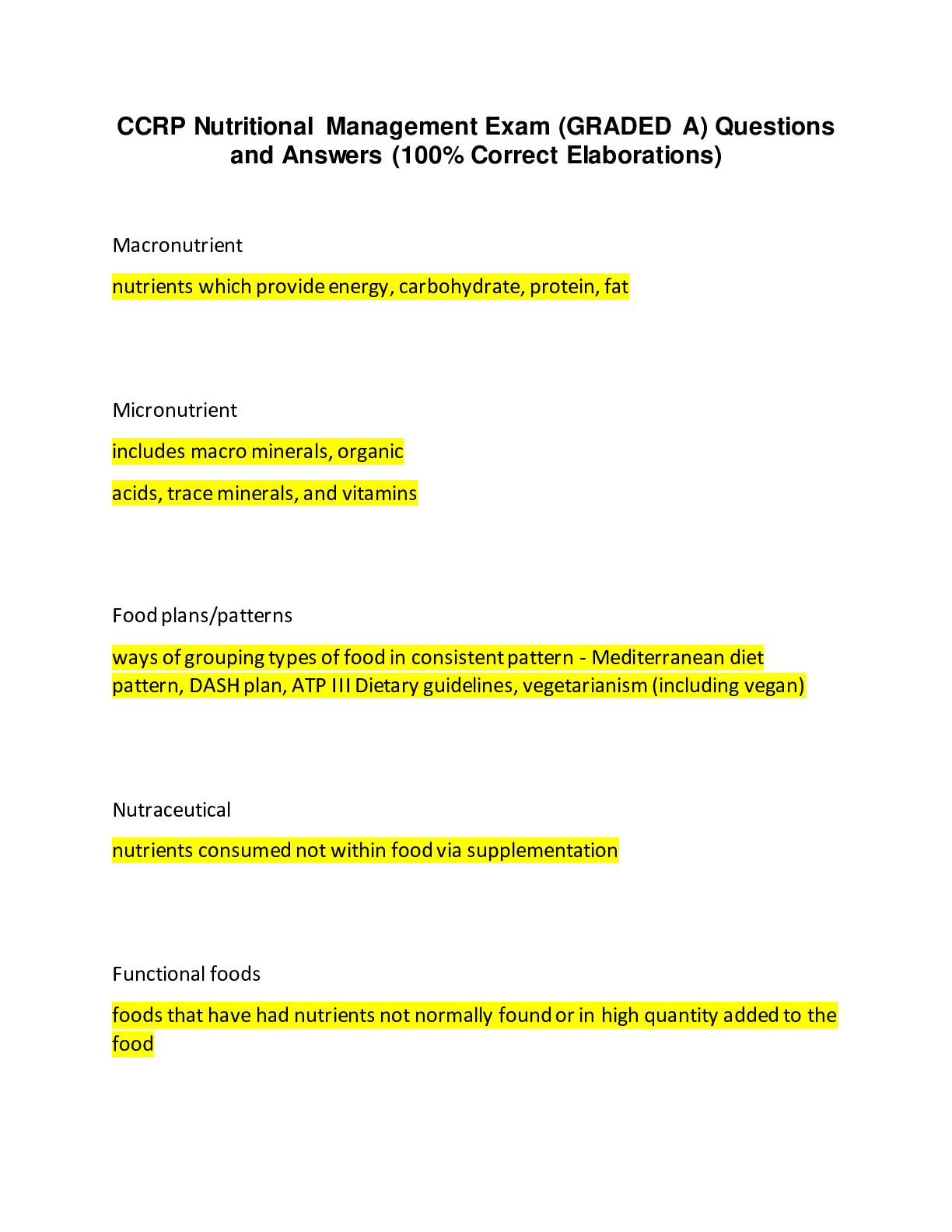
Buy this document to get the full access instantly
Instant Download Access after purchase
Add to cartInstant download
We Accept:

Also available in bundle (1)

CCRP AACVPR TESTS COMPILATION PACKAGE DEAL (100% Correct Solutions)
CCRP AACVPR TESTS COMPILATION PACKAGE DEAL (100% Correct Solutions)
By Goodluck Academia 8 months ago
$20.5
13
Reviews( 0 )
$10.50
Document information
Connected school, study & course
About the document
Uploaded On
Oct 03, 2023
Number of pages
41
Written in
Additional information
This document has been written for:
Uploaded
Oct 03, 2023
Downloads
0
Views
92






.png)






